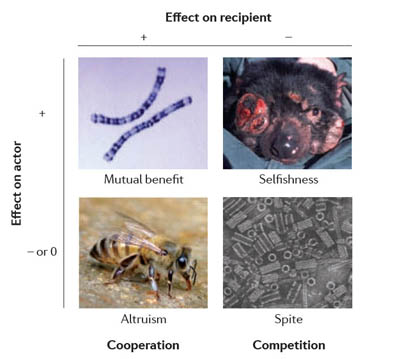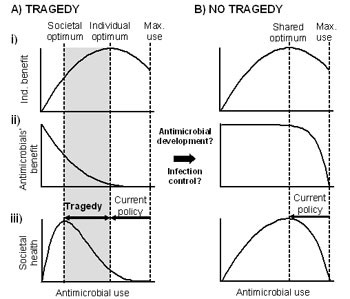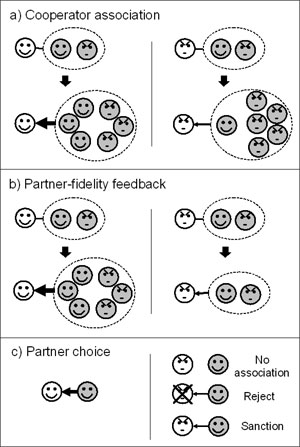Theoretical biology has played a central role in our understanding of the evolution of social behaviour. In addition to working with specific biological groups, such as the microbes and the insects, we also work on developing and summarising the theory of social evolution. This includes attempts to diffuse recurring debates in social evolution.
Debates in social evolution
While central to progress in the field, theory has proved to be a source of continuing squabbles and debates over which modelling framework should be used e.g. inclusive fitness theory versus multilevel selection theory. Some of these debates are fruitful but others have proved downright silly. At the heart of the silly debates are three key missteps. First is the idea that one modelling framework is fundamentally correct while another is incorrect. In reality, "all models are wrong, but some are useful" (George Box) and we should choose the best tool for a particular question. The second misstep is to change the key definitions of cooperation, altruism and alike without acknowledging the changes, which leads to debates where people are not talking about the same thing. Finally, debates can arise because people conflate the concept of a modelling approach with the concept of an evolutionary process. Consider one evolutionary process - the evolution of the worker caste in social insects - one can explain this in terms of multiple equivalent modelling approaches, including inclusive fitness and multilevel selection. But this does not mean that there are competing explanations, they are just different ways of phrasing the same problem. This is all discussed more fully here:
Foster KR 2009 A defense of sociobiology. Cold Spring Harbor Symposium on Quantitative Biology, Cold Spring Harbor Press,74: 403-418.
With further discussion here:
Wenseleers, T, Gardner A, Foster KR 2010 Social evolution theory: a review of methods and approaches. In: Social behaviour: genes, ecology and evolution (Tamas Szekely, Allen J. Moore & Jan Komdeur, eds.). Cambridge University Press; Foster, KR 2008 Behavioral ecology: Altruism. In: Encyclopedia of Ecology, pp 154-159. Elsevier; Gardner A & Foster KR 2008 The evolution and ecology of cooperation: history and concepts. In: Ecology of Social Evolution. (J. Korb & J. Heinz eds.), pp 1-36. Springer; Foster, K.R. 2006. Balancing synthesis with pluralism in sociobiology Journal of Evolutionary Biology, 19: 1394-1396
 The social evolution of molecular systems
The social evolution of molecular systems
We believe that the study of social evolution is important in understanding the evolution and form of molecular systems. It is often assumed that molecular systems are designed to maximize the competitive ability of the organism that carries them. In reality, natural selection acts on both cooperative and competitive phenotypes, across multiple scales of biological organization. This is important in understanding the molecular biology of a wide range of phenotypes, from the selfish genetic elements that disrupt genomes, through metabolism, multicellularity and cancer, to behaviour and the organization of animal societies. Read more here:
Foster KR. 2011 The sociobiology of molecular systems. Nature Reviews Genetics, 12: 193-203; Foster, K.R., Parkinson, K. and Thompson, C. R. L. 2007 What can microbial genetics teach sociobiology? Trends in Genetics, 23:73-80; Foster KR., Shaulsky G, Strassmann, J. E., Queller, D. C., Thompson, C. R. L. 2004. Pleiotropy as a mechanism to stabilise cooperation. Nature 431: 693-696
The tragedy of the commons
This expression made famous by Garret Hardin (1968) captures the essence of the problem of the evolution of cooperation. The phrase refers to common land to which many people have rights. Every herdsman knows that putting too many cows upon a pasture will eventually destroy it by overgrazing. However, when  pastures are a shared commons, the benefit of adding a cow goes entirely to the owner (the individual) but all herders share the cost (society). The rational solution for an individual is to keep adding cows, even though this leads to the deterioration and possible collapse of the pasture at a large cost for all. Similarly, simple evolutionary models predict that strong selection for competition and selfishness in social groups will cause the collapse of cooperation.
pastures are a shared commons, the benefit of adding a cow goes entirely to the owner (the individual) but all herders share the cost (society). The rational solution for an individual is to keep adding cows, even though this leads to the deterioration and possible collapse of the pasture at a large cost for all. Similarly, simple evolutionary models predict that strong selection for competition and selfishness in social groups will cause the collapse of cooperation.
Understanding what solves the tragedy of the commons is closely linked to understanding the evolution of cooperation. But they are not identical questions. In the former, the focus is on whether an individual will perform a particular behaviour (e.g. helping to build nest) while the latter is concerned with the effect of cooperation and conflict on overall group success (the benefits that the nest provides). We developed a way of thinking about the latter problem using multi-level selection models, which divide the world up into "individual" and "group effects". The trick is then to use the evolved group performance as a measure of the severity of tragedy. Applying this logic to the evolution of social groups shows that diminishing returns reduce tragedy (Foster 2004). It also brings new insight to the crisis of antibiotic overuse in our own societies (Foster and Grundmann 2006). Finally, one can also show that the tragedy of the commons may be weaker in nature than expected by simple microevolutionary models but considering the effects of conflict on extinction. That is, if conflict ridden species are more likely to go extinct than cooperative ones, over evolutionary time we can expect to see cooperation enriched through species-level selection (Rankin et al. 2007). We have also found evidence for this process in experiments with the termites (Korb and Foster 2010).
Foster KR. 2004. Diminishing returns in social evolution: the not-so-tragic commons. Journal of Evolutionary Biology, 17:1058-1072; Foster K.R. and Grundmann, H. 2006. Do we need to put society first? The potential for tragedy in antimicrobial resistance. PLoS Medicine, 3(2): e29; Rankin, D. J. , López-Sepulcre, A., Foster, K.R. Kokko, H. 2007. Species-level selection reduces selfishness through competitive exclusion. Journal of Evolutionary Biology, 20: 1459-1468.
 The evolution of mutualism: cooperation among species
The evolution of mutualism: cooperation among species
Compared to the study of within species cooperation, there has been relatively little work on the evolution of cooperation between species. Particularly, we lack theory for the evolution of mutualisms that bears anything like the generality obtained through the work of Hamilton (1964) and others. We developed a simple and general model of mutualisms which captures three main feedbacks benefits that favour mutualism (Foster and Wenseleers 2006). First, being mutualistic may mean that an individual tends to associate with the more cooperative genotypes of the other species (cooperator association). Second, when mutualism improves the fitness of a partner species, this may improve it phenotypic ability to return aid (partner-fidelity feedback). Finally, the partner species may have a specific behavioural adaptation that preferentially directs aid to more mutualistic individuals (partner choice). We then extended this with a more specific model that investigates the coevolution of partner choice and cooperation in mutualisms (Foster and Kokko 2006).
Foster, K.R., Wenseleers, T. 2006. A general model for the evolution of mutualisms Journal of Evolutionary Biology, 19: 1283-1293; Foster, K.R., Kokko, H. 2006. Cheating can stabilise cooperation in mutualisms. Proceedings of the Royal Society of London, Series B, 273: 2233-2239; Mitri S, Xavier J, Foster KR 2011 Social evolution in multispecies biofilms Proceedings of the National Academy of Sciences, 108 Suppl 2: 10839-46
Spiteful behaviour
Can natural selection favour traits that harm both the actor and recipient? At first, such spiteful behaviours don't seem to fit with the idea of natural selection. However, by going back to the original evolutionary definitions of spite, we found some social insects examples fit the original definitions of spiteful behaviour (Foster et al. 2000, 2001).
Foster KR, Wenseleers T, Ratnieks FLW. 2001. Spite: Hamilton’s unproven theory. Annales Zooogici Fennici, 38: 229-238; Foster, K. R., Wenseleers, T., Ratnieks, F. L. W. 2000. Spite in social insects. Trends in Ecology and Evolution, 15: 469-470.
